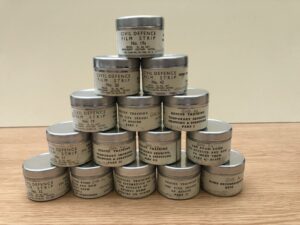 Between 1951 and 1956, the Home Office made a series of film strips focusing on aspects of Civil Defence. These ranged from case studies addressing the effects of the atomic bomb or the 1953 Ionian earthquake to emergency feeding guides and instruction manuals outlining how to care for the homeless.
Between 1951 and 1956, the Home Office made a series of film strips focusing on aspects of Civil Defence. These ranged from case studies addressing the effects of the atomic bomb or the 1953 Ionian earthquake to emergency feeding guides and instruction manuals outlining how to care for the homeless.
In 1952 two sets of films strips were produced offering guidance, and outlining plans, on Emergency Feeding. The first film strip introduced the large-scale kitchen equipment that the Ministry of Food would provide in the event of a raid. This Transportable Kitchen Unit (or TKU) could make up to 500 main meals or 1,600 snacks that could be kept warm for up to six hours in the event of a disaster. The second film strip focused on making a meal when no facilities were available, detailing how a makeshift stove could be created with bricks from the rubble of shelled houses.
The film strips were intended to supplement the existing, often partial, support offered by Flying Food Squads, which were created to provide food immediately (usually soup or sandwiches) in the event of an attack. These squads, considered the food equivalent of first aid, would usually only stay for 24-48 hours and so the remainder of the film strips focused on how to use the TKUs and more in-depth details on constructing makeshift kitchens if no equipment was available.
These film strips start by highlighting the importance of large-scale planning in the era of atomic bombs. As a collection, they show how seriously the UK Government took disaster preparation and how wide-ranging and detailed their plans were. They looked at examples that had happened elsewhere (such as the Ionian Earthquake) and created plans to cover all eventualities.
The booklets for the initial film strips had “Notes for the Trainer” on the first page, instructing the instructor, by explaining how to deliver the information – including directions such as “Have a DRAMATIC SENSE and a PLEASING MANNER” – alongside a guide on how to use the film strip itself. When the information was updated in 1956, with a new set of film strips and lecture notes created, such guidance was now absent, suggesting that the filmstrip was now an established, and commonplace, form of instruction, imagined here as a further aid to Civil Defence.
James Blackthorne